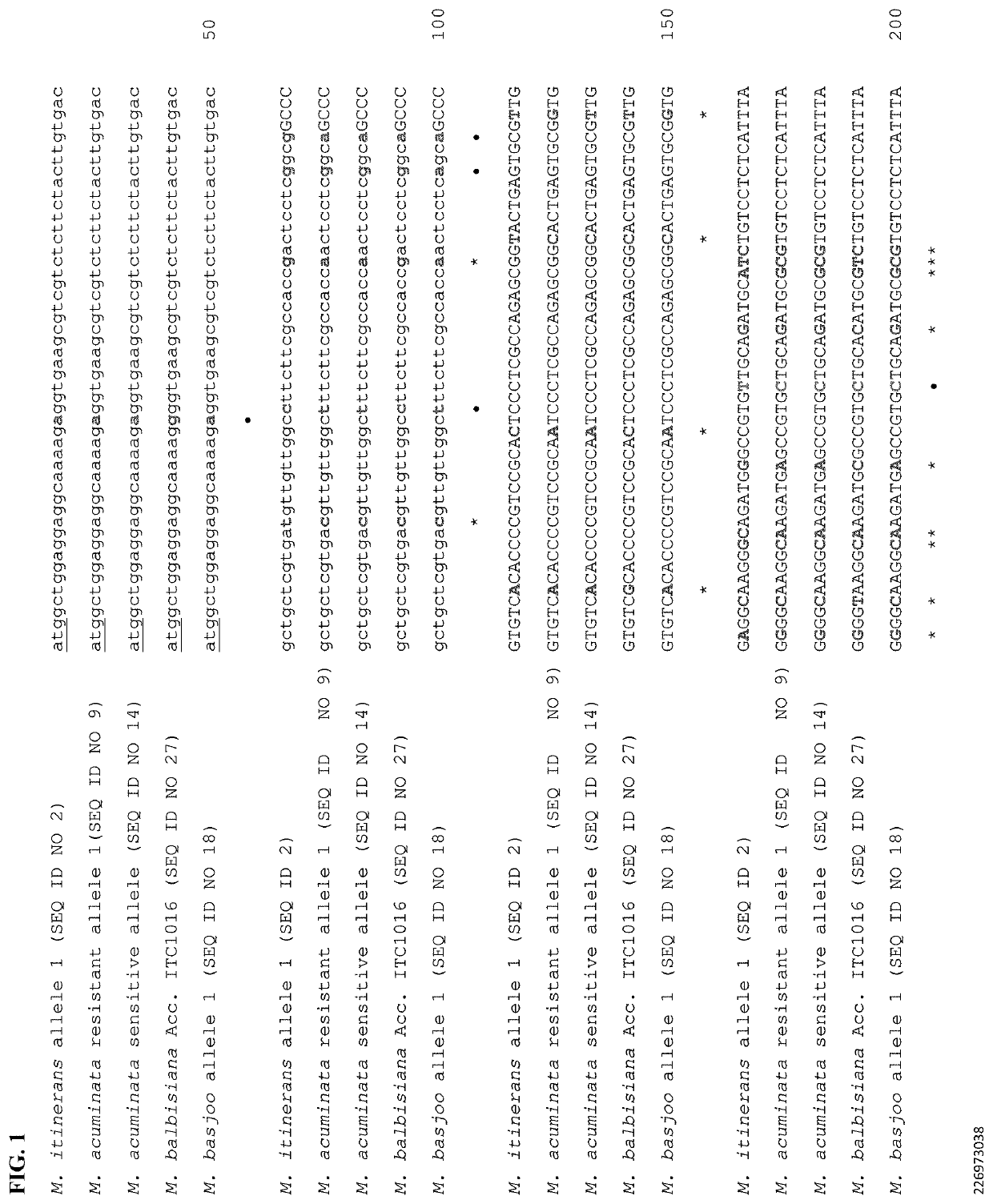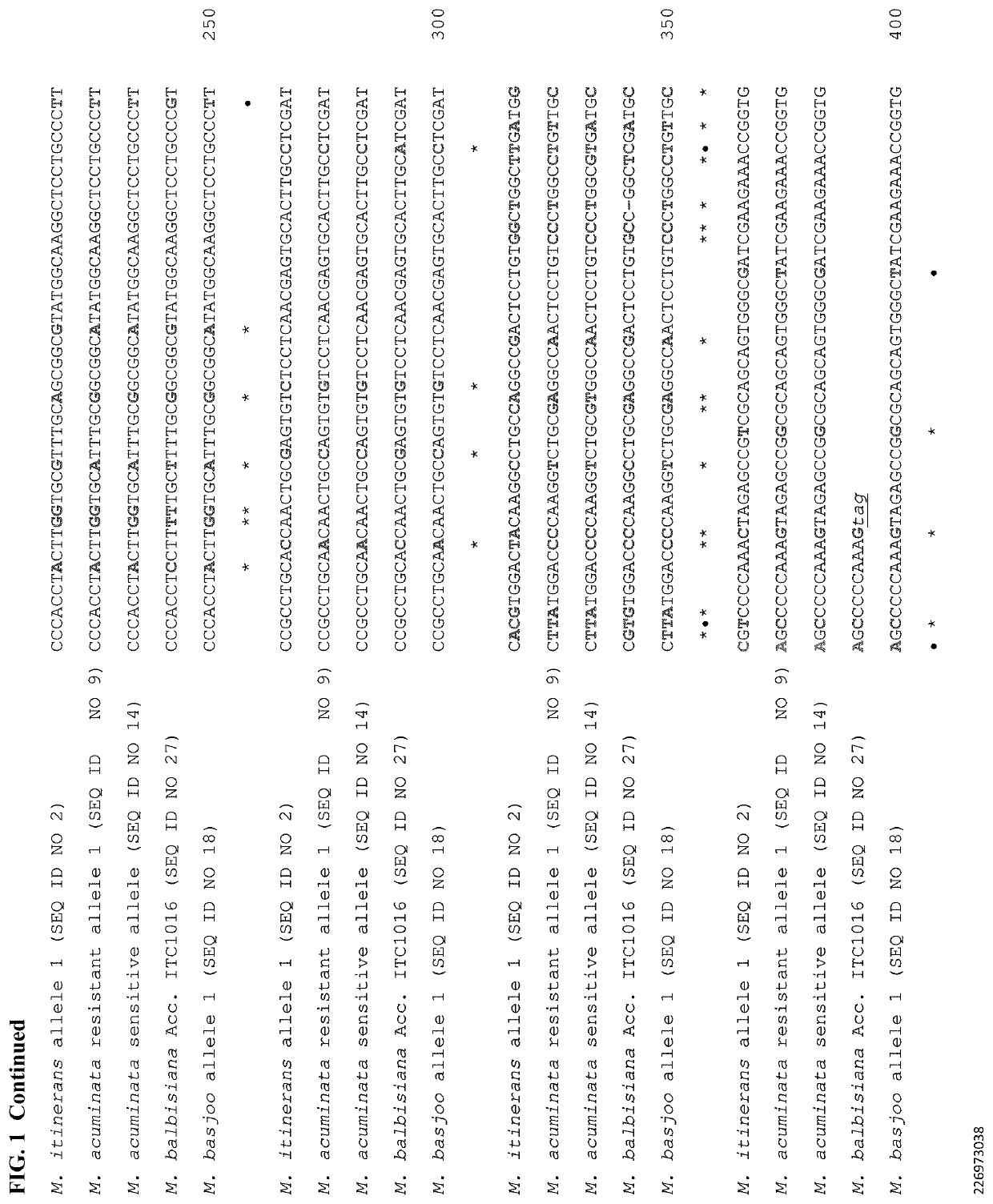Identification of resistance genes from wild relatives of banana and their uses in controlling panama disease
a technology of resistance genes and wild relatives, applied in the agricultural industry, can solve the problems of i>fusarium /i>wilt, the current expansion of the panama disease epidemic is particularly destructive, and the importance of crops is now severely threatened by i>fusarium /i>wil
- Summary
- Abstract
- Description
- Claims
- Application Information
AI Technical Summary
Benefits of technology
Problems solved by technology
Method used
Image
Examples
example 1
nd Materials for Sequencing
[0378](1) Material
[0379]Fresh and lyophilized banana leaf tissues were obtained from Bioversity International (Leuven, Belgium), Inter-TROP CRB Plantes Tropicales (Guadeloupe), and the IITA Genebank (Ibadan, Nigeria), Plant Delights Nursery (Raleigh, N.C.), and The Flower Bin (Longmont, Colo.).
[0380](2) RNA
[0381]Total RNA was extracted from fresh, frozen, and lyophilized banana leaves using a modified Ishihara protocol (Ishihara et al., 2016). Approximately 100 mg of fresh or frozen banana tissue was ground to a powder using a clean, dry-ice cooled mortar and pestle that was treated with RNase Away™ (Invitrogen, Carlsbad, Calif.). Approximately 20-30 mg of lyophilized banana tissue was homogenized in a Lysing Matrix D Tube (MP Bio, Santa Ana, Calif.) without liquid. One milliliter of polyphenol lysis buffer (800 μl RLT buffer (Qiagen, Germantown, Md.), 200 μl of Fruit-mate (Takara, Mountain View, Calif.), and 10 μl of β-mercaptoethanol) was added to each s...
example 3
e Breeding of Banana
[0423]Tetraploid versions of FW-sensitive Cavendish cultivars (M. acuminata; AAAA) are available or can be developed via large pollination / breeding programs focused on creating, identifying and isolating the relatively low percentage of tetraploid progeny that are produced (e.g., Aguilar Moran, J. F., 2013, Improvement of Cavendish Banana cultivars through conventional breeding, Acta Hortic. 986:205-208; Jenny et al., In Jacome et al., editors, Mycosphaerella leaf spot diseases of banana: present status and outlook, Proceedings of the 2nd International Workshop on Mycosphaerella leaf spot diseases held in San Jose, Costa Rica, 20-23 May 2002, Session 4, pages 199-208) or by subjecting diploid AA genotypes to in vitro polyploidization (Amah et al., November 2019, Frontiers in Plant Science, Vol. 10, Article 1450, 12 pages).
[0424]Diploid versions of FW-resistant FusR1 (AA) of M. acuminata ssp. banksia can be identified or developed using methods known to those skil...
example 4
and Methods for Plant Transformation
[0428]Banana transformation systems will use sterile material of selected banana strains. A variety of tissue culture and transformation methodologies will be used to increase the likelihood of success. See, for example, the transformation protocols described in Ploetz (2015, Phytopathology 105:1512-1521), U.S. Pat. Nos. 7,534,930; 6,133,035; Sagi et al., Bio / Technology 13, 481-485, 1995; May et al., Bio / Technology 13, 485-492, 1995; Vishnevetsky et al., Transgenic Res. 20(1):61-71, 2011; Paul et al. (2011); Zhong et al., Plant Physiol. 110, 1097-1107, 1996; Dugdale et al., Journal of General Virology 79:2301-2311, 1998; Mohan and Swennen (editors), 2004, Banana improvement: cellular, molecular biology, and induced mutations, Science Publishers, Inc.; and, Remy et al., 2013, Genetically modified bananas: Past, present and future, Acta Horticulturae 974:71-80, each of which is expressly incorporated herein by reference in their entireties.
[0429]The...
PUM
| Property | Measurement | Unit |
|---|---|---|
| threshold | aaaaa | aaaaa |
| pH | aaaaa | aaaaa |
| volumes | aaaaa | aaaaa |
Abstract
Description
Claims
Application Information
 Login to View More
Login to View More - R&D Engineer
- R&D Manager
- IP Professional
- Industry Leading Data Capabilities
- Powerful AI technology
- Patent DNA Extraction
Browse by: Latest US Patents, China's latest patents, Technical Efficacy Thesaurus, Application Domain, Technology Topic, Popular Technical Reports.
© 2024 PatSnap. All rights reserved.Legal|Privacy policy|Modern Slavery Act Transparency Statement|Sitemap|About US| Contact US: help@patsnap.com










